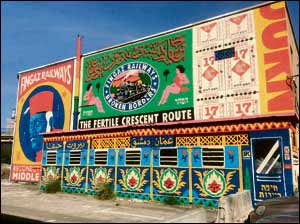 | |
| Haifa dream of rail route connecting Middle East | |
EVERYWHERE in what is commonly known as ‘downtown’ Haifa, the sound of drilling, hammering and constant shouting of workmen from scaffolding can be heard above the din of the traffic.
For the area’s business and office workers, the background music of gentrification, so common today in port areas all over the world, is a more than welcome sound. The port area of Haifa is where, until the late 1960s, so many sea weary immigrants, including this writer, first set foot on the soil and touched the soul of the Jewish homeland. However, gradually over a number of decades, the lower part of the city began to lose its pride as the buildings became derelict, ugly eyesores with ladies of the nigh' propping up their doorways, day and night. I entered the country that was to become my home in the mid-1960s through Haifa port, a member of a group of Shnat Sherut from Britian who had sailed out of Marseille five very stormy days beforehand. My first sight of the city on a mountainside was at the crack of dawn from the upper deck of the ZIM ship MS Moledet. We young Brits stood with other non-Israeli and Israeli passengers on the deck watching in awe an unforgettable glorious sunrise over Mount Carmel. Rays of light bounced off the golden roof of the Bahai Temple and the whiter-than-white buildings of the Bahai complex and areas sitting among the luxuriant greenery of the Carmel. The Israeli-born travellers returning home and the first timers to the land, overcome with emotion, joined hands, singing and dancing the hora as the ship slowly pulled in to port. Like so many before, we passed through Gate No 5, known as the Palmer Gate — named after Sir Frederick Palmer the British engineer who planned and built the Port of Haifa in the 1920s — climbed into the back of a truck and were transported to a kibbutz half an hour away. A day later, I began work in the banana plantation, cutting down enormous leaves and tackling hordes of revolting spiders that lived within. With the present day gentrification, many of the then none-too -architecturally eye-catching British Mandate period administrative buildings we saw portside when alighting the Moledet, have been attractively renovated, while others have been demolished and rebuilt. Student accomodation, centres of study — part of the Haifa Port Campus — and other academic colleges, have risen from the rubble. The area has now been revitalised as students create a vibrant wave of social life around newly opened pubs, clubs and eateries. It has also attracted artists and other young people, some from the centre of the country where the cost of living is so much higher, to central Haifa, now definitely on its way up. Other renovated buildings are now home to start-ups and already established hi-tech companies, as well as art galleries, boutiques and trendy coffee shops and sandwich bars. An abundance of works of art in public spaces, incredible creative artwork on the walls and small buildings renovated as private housing, their small balconies enclosed with decorative wrought iron railings, all add to the atmosphere of an area pushing forward, climbing out of the doldrums, regaining lost pride and getting firmly back on the map. One of the most eye-catching works of art can be found on a building that is basically the vision of a crew of street artists wishing to hop on board a future peace train — one that would travel from country to country in the Middle East as trains did in the days of the Ottoman Empire. Participating in a City of Haifa street art festival, Israeli Arab and Jewish artists collaborated with street artists from Germany, Ireland and Britain, their combined massive mural covering an old building just a short distance from the original tracks of the historic Hejaz Railway. The mural reflects the artists’ collective dream of a return to the good old days of rail travel from Haifa to Damascus, Beirut, Amman and Mecca. The Finjaz Railway mural features text in English, Hebrew and Arabic, the oh so bright colours reminiscent of psychedelic art of the 1970s, the playful, imaginative images on the wall a youthful promo advertising a possible future railway reconnecting the people of the Middle East. Inshallah!
|
 ON TRACK: The Finjaz Railway mural recalling the days when train journeys statring in Haifa could take travellers all over the Middle East
ON TRACK: The Finjaz Railway mural recalling the days when train journeys statring in Haifa could take travellers all over the Middle East